With a total of four chapters, indicative of a regular release schedule, this month’s content from mangaka Kōhei Horikoshi has a lot on offer that should be appreciated but could easily be overlooked. Although the series may have stepped away from high-octane action from the time being, this does not diminish the quality of the material that Horikoshi is presenting us with. While there is humour and hijinks aplenty in recent chapters, and it is quite clear that Horikoshi is having incredible fun acting out zany scenarios with these characters he cares for in a universe he has crafted, there is undoubtedly meaningful substance to be found throughout.
This combination of further developing the 1-A class members, exploring the intra-class dynamics, and presenting more instances of world building now, will all surely enhance the quality of the material that is to come in the future. Not skimping on laying the foundation for future events, and instead doing so in an entertaining but effective manner, is something Horikoshi does ever so well and thus should be praised accordingly.

So while the majority of this month’s content takes place at U.A. High, the first chapter (titled ‘With Eri’) is actually set in two different locations. The first of these is a hospital, where Togata, Deku and Eraserhead pay Eri a visit. The reason for this meeting is presented through a flashback, wherein Eraserhead informs those needing supplementary classes that Eri has requested to see both Deku and Togata. A subtle detail to note here is that Tokoyami is also receiving supplementary lessons, and this may then suggest that he too was undergoing a work study with an undisclosed pro hero, bearing in mind that Tokoyami was the only student not present when the other four returned from their Yakuza mission.
Upon returning focus to the hospital, and the meeting between Eri and the others itself, we are presented with more important information. The first of this is the confirmation that the size of the horn on Eri’s head indicates the potency of her quirk, and as such, its current diminutive size should not be a cause for concern. The next important detail is that Eri has been purposefully kept out of the loop, regarding the fate of Nighteye, in order to reduce the mental strain and stress that is already troubling her. So while this is not something to worry about just yet, it would not surprise me if her finding out leads to a potentially dangerous situation. What comes next in the chapter though, is something that truly heightens the respect I have for Horikoshi as a writer. While many series would gloss over the long-term effects of abuse, and the longevity its influence should realistically have on the parties who were affected (especially those that fall under a typically innocent demographic), Horikoshi instead highlights it as a way of indicating the difficulty of a true hero’s job. This lingering effect is something Horikoshi has touched on before, for example with Todoroki’s gradual coming to terms with the use of the fire quirk he inherited from his previously abusive father, and it is something I’m glad he is not forgetting to address as it contributes significantly to the impact of the narrative.
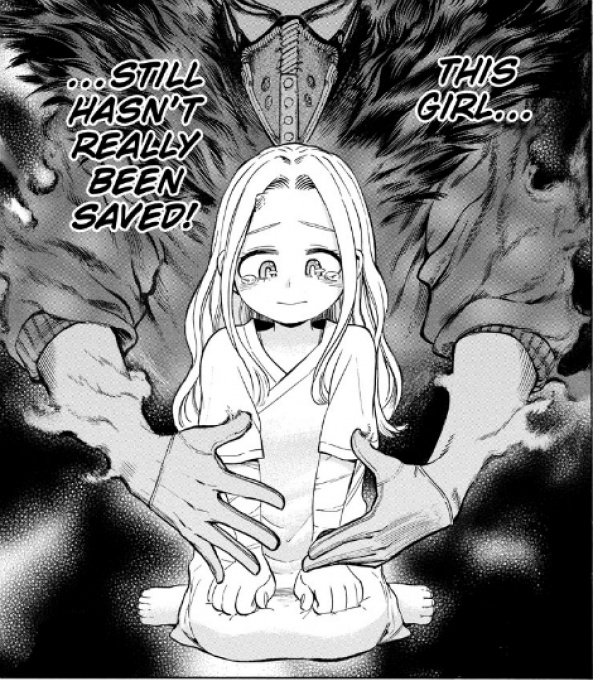
While the important information provided by this scene is broken up by effective humour, arguably the greatest example of this comes towards the backend of this chapter. After having learned that Eri will be visiting U.A. High for the upcoming School Festival, and that Togata will be accompanying her during this event, the focus shifts briefly to Kenji Tsuragamae; the Hosu Chief of Police who we first saw following the confrontation with Stain. It would appear as if he is trying to trace the location of a particular content creator, who is bouncing around the signal to throw the police of their scent. This then swiftly transitions into showing us the video that the apparent culprit most recently uploaded, which while showing some impressive feats for the criminal, is undoubtedly the most comedic introduction to an antagonist we’ve seen thus far in the series. From his dialogue, to his appearance, to the fact that he only incapacitated the heroes who attempted to stop him as opposed to seriously injuring them, it is obvious that Gentle is being used to contrast heavily with the methods of Overhaul who came before him.
Continued belowHorikoshi is sure not to portray him as weak though, as he is able to easily handle numerous pro heroes without sustaining any kind of injury, all the while posing for the camera and conveying his true goal of leaving his name in the annals of history. At the same time though, Gentle’s quirk and full potential are being hidden from both the readers of the series and the in-universe watchers of the video he is uploading, presumably to hide his identity from the police, who would otherwise use the quirk registry to pinpoint him more easily. While the comedy is on-point, and works perfectly in distinguishing him and his camerawoman/editor La Brava from the previous antagonists in the series, I am indeed interested to see just where Horikoshi takes this duo. Will their ties to a media platform lead to them having an important knock-on effect in the wider context of the story, or will they be utilised as a reoccurring antagonistic (yet comedic) party in the vein of Team Rocket? Either way, I welcome their involvement as a relative breather from the intensity of recent months, and am confident that Horikoshi will make good on their potential, depending on the direction he intends on taking them moving forward.
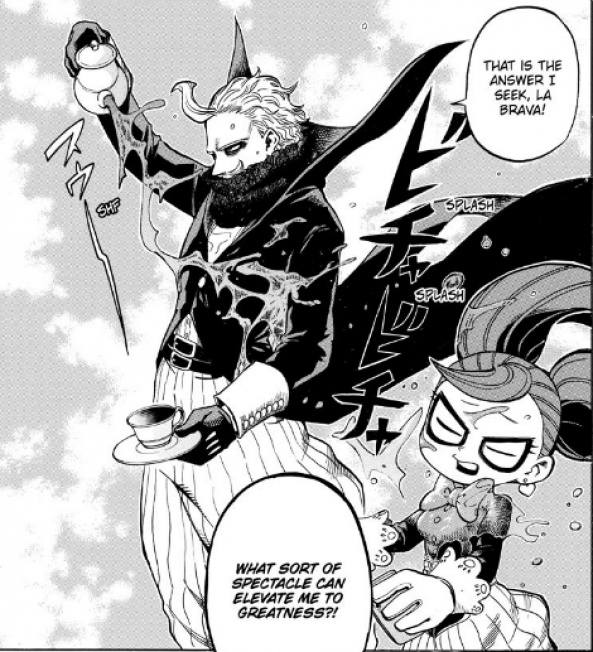
The following chapter (aptly titled ‘Gentle and La Brava’) opens with a wonderful cover page of the newly introduced pair, which effectively display the disparity in their sizes and statures, as well as parodying the YouTube logo. Then, we move straight into La Brava watching the first video Gentle ever made, which was apparently six years prior to the current time. This is worth noting, as it is the same year in which All Might and All For One clashed for the first time, resulting in the serious injuries they both sustained. From there we are given incredibly interesting worldbuilding, as Gentle lists three ‘heroes’ and three ‘villains’ who seemingly stand above the rest in terms of fame. Regarding the heroes here, All Might is a very obvious choice, but the others are intriguing to say the least. While we’ve seen Crimson Riot before, as he is the inspiration behind Kirishima’s image and hero name of Red Riot, it was not made clear that he held a noticeably important position at some point in the world of heroics. With this clarification, I begin to wonder just what happened to Crimson Riot, and whether he’s still active today in some capacity. As such, I’m interested to see if (or rather when) Horikoshi will address such questions. The final hero on Gentle’s list is Brave, who is the one hero mentioned who we have no clue about. Only time will tell if we will also get to learn about him, but with such a strikingly straightforward name as that, I certainly hope that’s the case.
Again, like All Might, it only makes sense to have All For One on the list of key villains, but it’s another who catches my eye to a greater extent. While I like the design of the Peerless Thief Oji Harima, and I’m interested to see if he too is still active, the idea of Destro and his Metahuman Liberation Army is utterly captivating. Although we know that in the past there was great division between the rising tide of quirk-users and the previous majority of quirkless, which required a significant time to settle and legislate for (slowing the advancement of technology as a result), we have had no indication as to specific individuals who were involved until now. The truly fascinating part to me about this though is that Destro is still regarded as a villain, despite society eventually accommodating the now clear majority of quirk-users. This would then suggest that the methods Destro endorsed, or perhaps the views he held of all quirkless, were widely seen as extreme. With all of this in mind, I truly hope Horikoshi explores the seemingly rich history of this universe he has created in greater depth at some point.
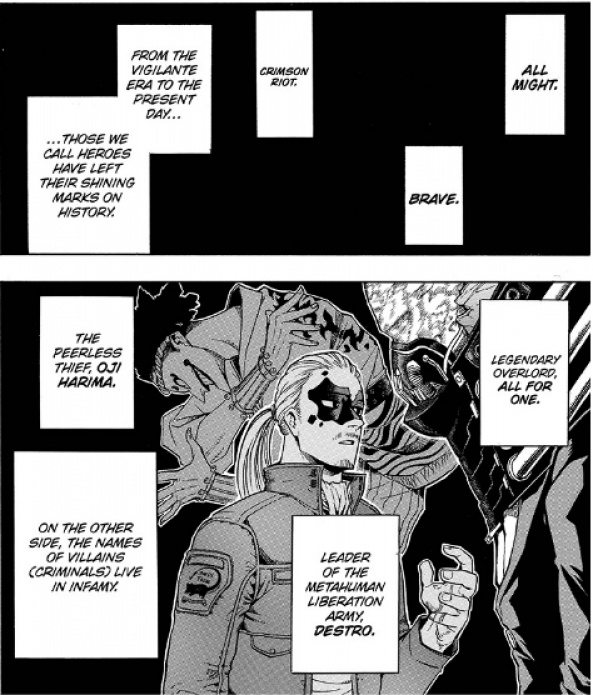
Outside of this though, the rest of Gentle and La Brava’s appearance in this chapter presents us with some enjoyable humour that looks to parody the state of online media. It also affirms his intentions to raise his profile without resorting to violence, despite that having worked in recent times for Stain and Shigaraki, as well as hinting at Gentle’s quirk; which looks to be touch-activated and related to bouncing (indicated by the inclusion of a ‘bounce’ sound effect). Following this we place the focus back on U.A., as we are shown the friction that exists between 1-A and the other classes, which is picked up on by both Bakugo and Eraserhead. While the rest of the class – led by Ida and Jiro – first decide on the style of music they’ll be performing at the School Festival, they then proceed to assembling the band. In doing so, Bakugo’s natural talent seems to shine once more as Sero provokes him cleverly into proving his ability as a drummer.
Continued belowDespite this though, Bakugo is not willing to aid his classmates in putting on their performance, if they’re doing so solely to please the other U.A. students. As mentioned before he understands well that other members of the school hate 1-A, due to the stress their villainous encounters have brought upon the entire school community, even if it was through no fault of their own. As such, he strongly believes they should perform because they want to, as opposed to doing so to help the other kids relax. This turn of events is brilliantly handled, as it is entirely in keeping with Bakugo’s established character. His awareness helps him to see the friction between the classes, his natural ability puts him in a position where he is wanted to perform, and then his drive to give 100% at all times and to be the best is what affirms his desire to only play for the initial benefit of him and his classmates. A scene such as this really does communicate to me that Horikoshi truly understands his characters, and as such, adds a layer of believability to any kind of character interaction and exploration of a wider dynamic.
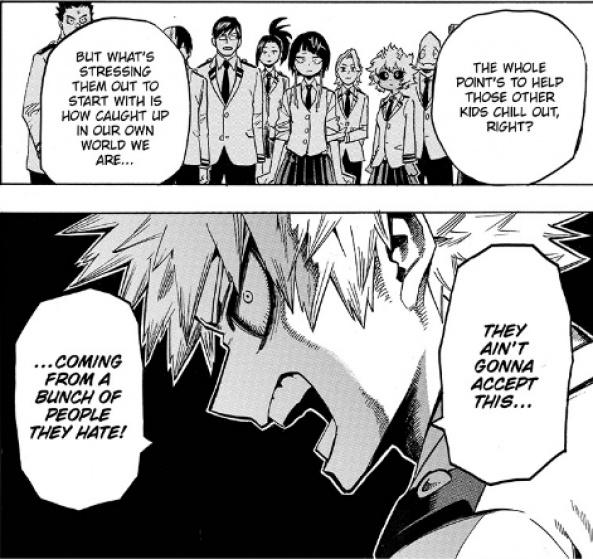
While the end of Chapter 171 provides the obvious confirmation that Gentle’s plan for enhancing his reputation is to infiltrate U.A.’s School Festival, this is actually the last we see of Gentle in this month’s batch of chapters. Instead, Chapters 172 and 173 – titled ‘Prepping for the School Festival is the Funnest Part (Part 1) and (Part 2) respectively – provide a welcome look at more goings-on at U.A. in the run-up to the School Festival itself. Beyond Jiro on bass and Bakugo on drums, we see the finalising of the other necessary roles for the festival performance of Class 1-A.
Horikoshi dips into Yaoyorozu’s wealthy upbringing, as a means of understandably justifying her proficiency with the piano, and so she will be playing keyboard in the band. Kaminari and Tokoyami are then selected as the two guitarists, with Kaminari predictably wanting to shine (much like his quirk does) and Tokoyami stepping up despite his fear of the F Chord, as a meta-joke is made regarding the lacklustre height of Mineta’s character design. Jiro is also rather predictably chosen as the vocalist for the band, but not before some hilarious singing panels of Kirishima, Mineta and Aoyama; who has clearly become more involved in the class dynamic since the growth of his friendship with Deku. Alongside these assignments, the members of the staging team and dance squad are also decided upon, amidst further pages of brilliant comedy which is primarily driven by the ever-enthusiastic Ashido.

Alongside this light-heartedness though, Horikoshi does not neglect the growth of Deku, coming off the back of a particularly intense arc for him and his development. For the first time in some time, we are given a one-on-one interaction between Deku and All Might, which allows for a feeling of narrative progression alongside the slice of life hijinks. As part of this conversation, Deku is shown to be reflecting well on his own shortcomings in his most recent fight. This then leads to All Might wishing to give him advice, which moves the two outside and puts Deku in his sports gear. Horikoshi then treats us to a fantastic panel of Deku utilising 20% of One For All, before presenting a spread of Deku firing off a blast of wind through kicking.
This then leads to Deku reflecting on his entire journey with One For All thus far, and not just his experience with it when facing Overhaul. Horikoshi does well to succinctly set out the step-by-step progress that Deku has made so far, and then follow up on that by having Deku’s analytical muttering beat All Might to the punch when it comes to where Deku needs to go from this point. This combination of individual prior steps and a general refining of control, as opposed to randomly unlocking a new facet of a power, really does make Deku’s growth feel well earned and brilliantly thought out from a writing standpoint.
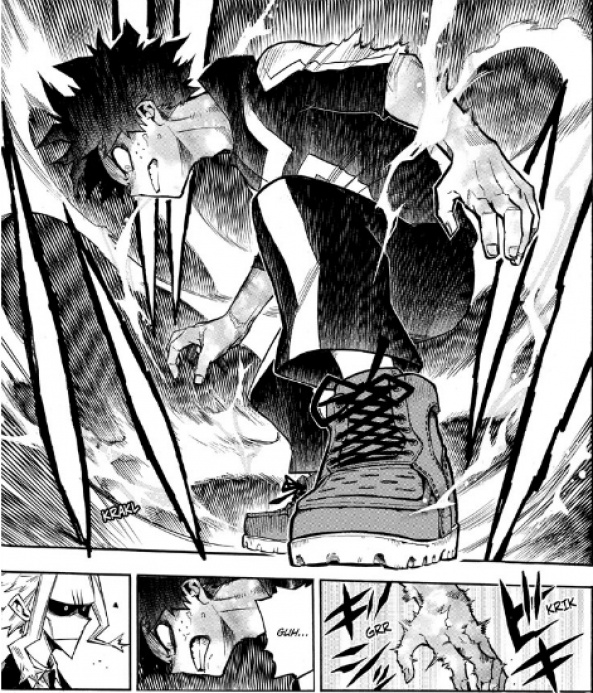
The final chapter of this month’s batch though, returns the focus to the School Festival. While Chapter 172 focused primarily on Class 1-A, Chapter 173 demonstrates what else will be on offer at the festival through the eyes of Deku, Togata and Eri, as they wander around U.A. This is fantastic to see, as it allows for worldbuilding in the more immediate vicinity to our main character. One such feature of this, throughout the chapter, is the introduction of a number of Togata’s fellow third-year students. The first are two Business Course students who seem well acquainted with Togata, and as such suggest to me that at some point during U.A.’s curriculum, the Hero Course and Business Course will likely work in tandem. The other two third years are seen through the re-introduction of Hado, as we are also introduced (through a flashback panel) to her beauty pageant rival Bibimi Kenranzaki of Support Course 3-G, along with a female student named Yuyu; who I would assume is a female Hero Course student like Hado. Through this interaction we are also reminded of Kendo, the class president of 1-B, who is also going to be taking part in the festival’s beauty pageant. This is because of the underground fans she has accrued since filming a commercial with Yaoyorozu, whilst interning under Uwabami, which is a nice throwback.
Continued belowIn addition to this, we also get to touch base with a number of already established U.A. students, and see what they’ll be doing for the School Festival. With Class 1-B we see Tetsutetsu, Awase and Monoma, who then proceeds to run his mouth as ever, by informing Deku that 1-B’s performance of ‘Romeo and Juliet and the Return of the Prisoner King of Azkaban’ will outshine their own performance. While the name of this parody is rather funny (as is the fact that Monoma refers to it as an original fantasy screenplay), the real treat is the panel that Horikoshi gives us, depicting numerous 1-B members dressed as characters from the three series that are referenced. This single image really does make me want to see more of this performance, as its potential for entertaining and amusing the masses is high, but unfortunately I have a feeling this may be all we get.

Beyond them though, we also get to see Hatsume of the Support Course once again, who has just finished her 202nd invention, and is excitedly preparing for the festival’s tech exhibition. While this latest ‘baby’ may be faulty and explode with comedic effect, it should be noted that the last time we saw Hatsume she was showing off inventions with far smaller numbers. As such, it is reasonable to assume that Hatsume may have created as many as 150 pieces of tech in only a few months. From this, it is clear just how much Deku and his fellow hero students may have to be grateful to this budding genius in the future. Also, it should be highlighted that we see Shinso of 1-C appear in a single panel. This manages to still say a lot though, as his breaking of wood with his bare hands further indicates that Shinso is working on his physique. Given that we saw him walk off with Eraserhead at the end of the first school semester, there is every chance that Eraserhead saw himself in the boy (in that his quirk too doesn’t grant him an advantage in combat like others, it instead just levels the playing field) and is now training him outside of school. I hope we see if this is indeed the case sooner rather than later, or at least just get some more from Shinso in the near future.
Finally, this batch ends on a somewhat ominous note. After Deku, Togata and Eri have finished inspecting the school, and Eri confirms her wish of seeing how the School Festival plays out, we are shown a brief interaction with Midnight and Nezu. After basically confirming that Nezu is indeed a lab rat, hence the enjoyment he gets from gnawing on some cheese, we are shown a flashback of the commissioner general of the National Police Agency (who we first saw after All Might’s retirement in Chapter 95) meeting with Nezu. For those that aren’t aware, the National Police Agency is akin to the FBI, except that it doesn’t have agents on the ground, and it is far more administrative.

The commissioner strongly suggests that the school show restraint with the festival, but Nezu implores that the festival should go ahead as normal, as a means of presenting his students with a bright and happier future. The compromise of this is increasing security, and agreeing to a total evacuation if any kind of alarm is tripped during the festival itself. The mention of the danger another problem at U.A. poses though is incredibly foreboding, and suggests that something bad may indeed be on the horizon. With that hanging over the festival, and the fact that Deku has been dropped from the dance squad by Ashido – presumably because of his utter lack of talent – I’m very interested to see just where Horikoshi takes the story from here.






